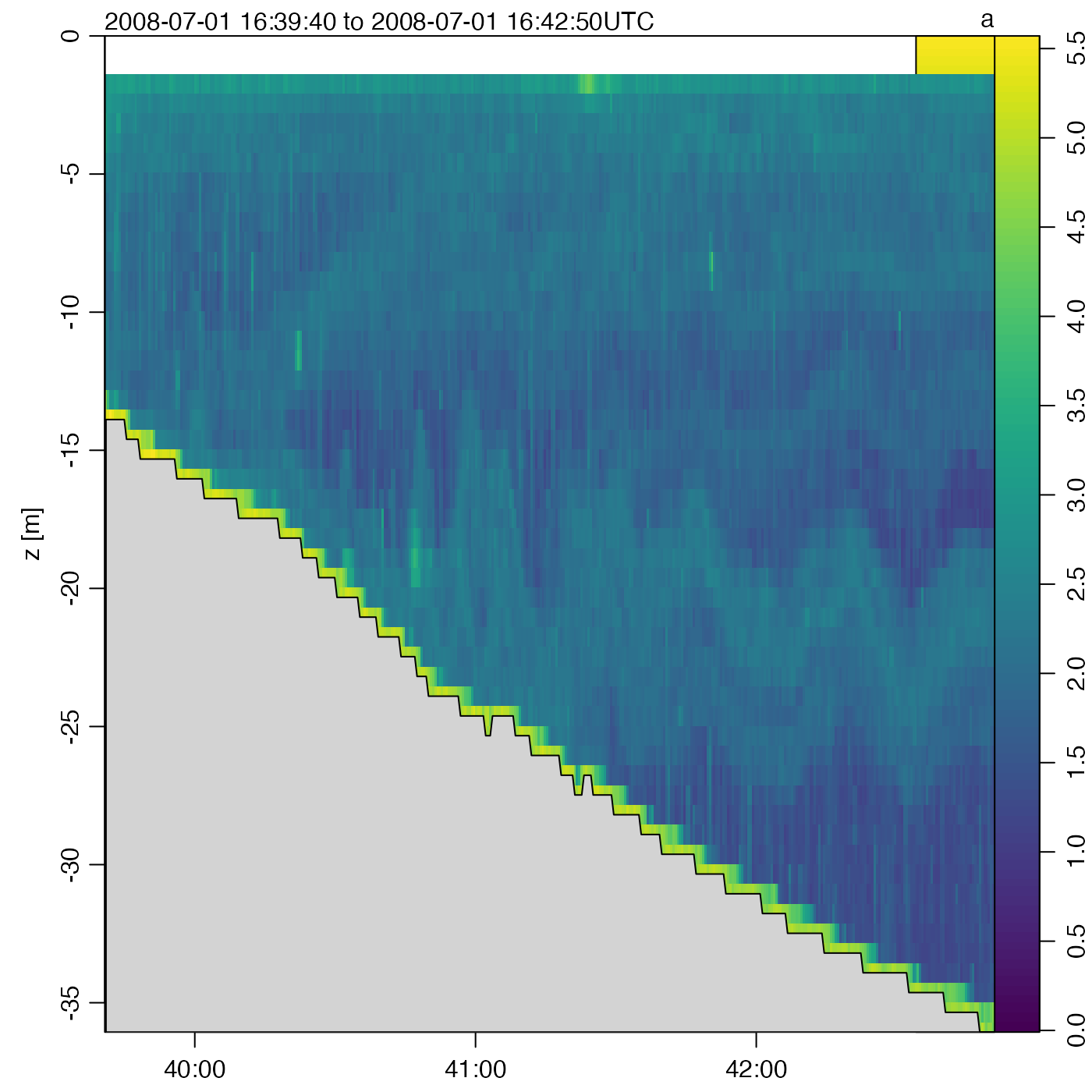Plot echosounder data.
Simple linear approximation is used when a newx value is specified
with the which=2 method, but arguably a gridding method should be
used, and this may be added in the future.
Usage
# S4 method for class 'echosounder'
plot(
x,
which = 1,
beam = "a",
newx,
xlab,
ylab,
xlim,
ylim,
zlim,
type = "l",
col,
lwd = 2,
despike = FALSE,
drawBottom,
ignore = 5,
drawTimeRange = FALSE,
drawPalette = TRUE,
radius,
coastline,
mgp = getOption("oceMgp"),
mar = c(mgp[1], mgp[1] + 1.5, mgp[2] + 1/2, 1/2),
atTop,
labelsTop,
tformat,
debug = getOption("oceDebug"),
...
)Arguments
- x
an echosounder object.
- which
list of desired plot types:
which=1orwhich="zt image"gives a z-time image,which=2orwhich="zx image"gives a z-distance image, andwhich=3orwhich="map"gives a map showing the cruise track. In the image plots, the display is oflog10()of amplitude, trimmed to zero for any amplitude values less than 1 (including missing values, which equal 0). Add 10 to the numeric codes to get the secondary data (non-existent for single-beam files,- beam
a more detailed specification of the data to be plotted. For single-beam data, this may only be
"a". For dual-beam data, this may be"a"for the narrow-beam signal, or"b"for the wide-beam signal. For split-beam data, this may be"a"for amplitude,"b"for x-angle data, or"c"for y-angle data.- newx
optional vector of values to appear on the horizontal axis if
which=1, instead of time. This must be of the same length as the time vector, because the image is remapped from time tonewxusingapprox().- xlab, ylab
optional labels for the horizontal and vertical axes; if not provided, the labels depend on the value of
which.- xlim
optional range for x axis.
- ylim
optional range for y axis.
- zlim
optional range for color scale.
- type
type of graph,
"l"for line,"p"for points, or"b"for both.- col
a function providing the color scale for image plots. This value is passed to
imagep(), which draws the images. Sinceimagep()defaultscoltooceColorsViridis(), that is effectively also the default for the present function. (Prior to 2023-03-18, the present function defaultedcoltooceColorsJet().)- lwd
line width (ignored if
type="p").- despike
remove vertical banding by using
smooth()to smooth across image columns, row by row.- drawBottom
optional flag used for section images. If
TRUE, then the bottom is inferred as a smoothed version of the ridge of highest image value, and data below that are grayed out after the image is drawn. IfdrawBottomis a color, then that color is used, instead of white. The bottom is detected withfindBottom(), using theignorevalue described next.- ignore
optional flag specifying the thickness in metres of a surface region to be ignored during the bottom-detection process. This is ignored unless
drawBottom=TRUE.- drawTimeRange
if
TRUE, the time range will be drawn at the top. Ignored except forwhich=2, i.e. distance-depth plots.- drawPalette
if
TRUE, the palette will be drawn.- radius
radius to use for maps; ignored unless
which=3orwhich="map".- coastline
coastline to use for maps; ignored unless
which=3orwhich="map".- mgp
3-element numerical vector to use for
par("mgp"), and also forpar("mar"), computed from this. The default is tighter than the R default, in order to use more space for the data and less for the axes.- mar
value to be used with
par("mar").- atTop
optional vector of time values, for labels at the top of the plot produced with
which=2. IflabelsTopis provided, then it will hold the labels. IflabelsTopis not provided, the labels will be constructed with theformat()function, and these may be customized by supplying aformatin the...arguments.- labelsTop
optional vector of character strings to be plotted above the
atToptimes. Ignored unlessatTopwas provided.- tformat
optional argument passed to
imagep(), for plot types that call that function. (Seestrptime()for the format used.)- debug
set to an integer exceeding zero, to get debugging information during processing.
- ...
optional arguments passed to plotting functions. For example, for maps, it is possible to specify the radius of the view in kilometres, with
radius.
Value
A list is silently returned, containing xat and yat,
values that can be used by oce.grid() to add a grid to the plot.
See also
Other things related to echosounder data:
[[,echosounder-method,
[[<-,echosounder-method,
as.echosounder(),
echosounder,
echosounder-class,
findBottom(),
read.echosounder(),
subset,echosounder-method,
summary,echosounder-method
